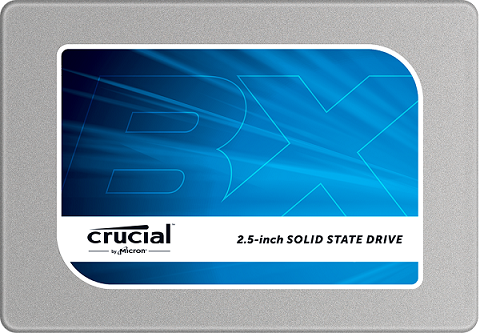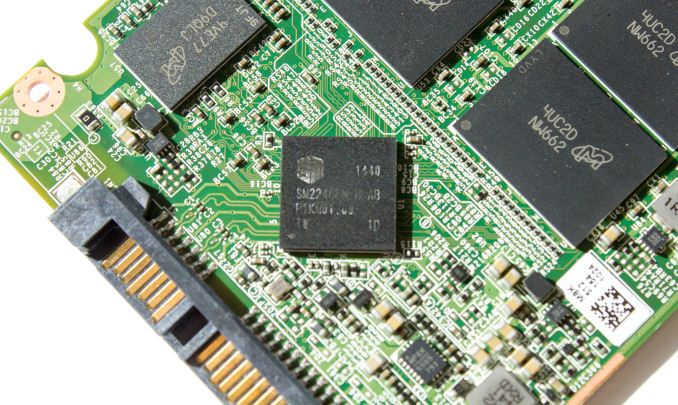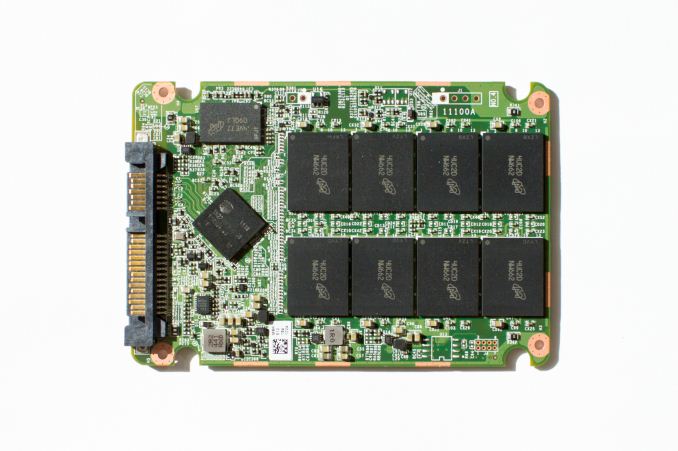Crucial BX100 (120GB, 250GB, 500GB & 1TB) SSD Review
by Kristian Vättö on April 10, 2015 1:20 PM EST- Posted in
- Storage
- SSDs
- Crucial
- Micron
- Silicon Motion
- BX100
- SM2246EN
- Micron 16nm

Crucial has been doing very well in the client SSD market during the past year. Crucial's/Micron's ability to quickly roll out the 16nm NAND node definitely paid off because the MX100 really nailed it when it came to cost and overall value. The MX100 set a new bar for mainstream SSD prices while still providing solid performance in typical client-level workloads. It gained a strong recommendation from us and has remained at the top of my "what to buy list" for nearly a year now, and honestly it has been one of the most popular mainstream SSD during its lifespan.
Back at CES Crucial introduced some fresh faces to its client SSD lineup by announcing the MX200 and BX100, which are replacing the MX100 and the aging M550. The MX200 is essentially a retail version of Micron's M600 that was launched last year and which we already reviewed, but the BX100 is a totally new product from several angles. First off, the 'BX' series is new to Crucial's lineup and denotes a budget-oriented drive, whereas the 'MX' brand is kept for higher performance drives. It has become a common strategy in the SSD industry to offer a mainstream drive that focuses solely on cost along with a higher performance model with better feature set for the enthusiasts and professionals. Crucial already kind of had that strategy with the M500 (later MX100) and M550, but the two lacked any real differentiation in both performance and feature set, so the BX100 and MX200 are here to fix that.
The BX100 isn't Crucial's first try with a low-cost drive as some of you may recall the infamous Crucial v4, which was frankly one of the worst SSDs I've ever reviewed. It looks like Crucial learned its lesson because we never saw a successor to the v4. Fortunately the BX100 has a lot more potential as is powered by Silicon Motion's SM2246EN controller. Crucial/Micron worked closely with Silicon Motion to develop the firmware for the BX100, so the firmware is unique to Crucial and we won't be seeing it in any other SM2246EN based drive. I've covered the technical details of the SM2246EN controller in our ADATA Premier SP610 review and our tests have shown that it's an excellent controller for mainstream client SSDs, so on paper at least the BX100 shouldn't end up the same way as the v4 did. Generally speaking Silicon Motion has been gaining a lot of market share lately and the new partnerships with Crucial/Micron and SanDisk has made the company become a tier-one controller manufacturer.
| Crucial BX100 Specifications | |||||
| Capacity | 120GB | 250GB | 500GB | 1TB | |
| Controller | Silicon Motion SM2246EN | ||||
| NAND | Micron 16nm 128Gbit MLC | ||||
| DRAM (DDR3-1600) | 256MB | 512MB | 1GB | ||
| Sequential Read | 535MB/s | 535MB/s | 535MB/s | 535MB/s | |
| Sequential Write | 185MB/s | 370MB/s | 450MB/s | 450MB/s | |
| 4KB Random Read | 87K IOPS | 87K IOPS | 90K IOPS | 90K IOPS | |
| 4KB Random Write | 43K IOPS | 70K IOPS | 70K IOPS | 70K IOPS | |
| DevSleep Power Consumption | 15mW | ||||
| Slumber Power Consumption | 115mW | ||||
| Max Power Consumption | 4W | ||||
| Encryption | N/A | ||||
| Endurance | 72TB | ||||
| Warranty | Three years | ||||
Since Crucial's motivation behind the BX100 is to differentiate the product lineup, the BX100 doesn't have the hardware encryption support that we got used to with the previous drives. While the SM2246EN is capable of supporting Opal encryption, it makes sense for Crucial not to include it in the BX100 because there's always additional validation costs that go along a feature. Besides, the MX200 has full encryption support and obviously Crucial wants to guide the buyers who need the feature towards the more expensive (and likely higher profit) MX200.
The BX100 does however have the same partial power loss protection that protects against lower page corruption during sudden power losses (I suggest you read the M600 review for the full details of Crucial's power loss implementation). The implementation itself is a bit different from the Marvell based drives (I don't have the details, but I suspect it has to do with the SM2246EN controller), but the design provides the same >200µs of holdup to ensure that ongoing upper page programs won't corrupt the data in the lower page.
The BX100 is using the same Micron 16nm 128Gbit MLC NAND as the MX100 and MX200. I covered Micron's 16nm NAND in more detail in the MX100 review, but in short it is a die shrink of the 20nm node and utilizes the same high-K dielectric cell structure which is likely the reason why Micron was able to roll out the 16nm so quickly with good yields (whereas Toshiba/SanDisk seem to be having issues with their 15nm node since it has yet to find its way into a shipping product).
| 120GB | 250GB | 500GB | 1TB | |
| Raw NAND Capacity | 128GiB | 256GiB | 512GiB | 1024GiB |
| # of NAND Packages | 4 | 4 | 8 | 16 |
| # of Die per Package | 2 | 4 | 4 | 4 |
| Over-Provisioning | 12.7% | 9.1% | 9.1% | 9.1% |
With the BX100, Crucial is moving to user capacities that are similar to Samsung's EVO SSD series. That gives the BX100 a little more over-provisioning over the traditional 2^n capacities and I also suspect that even hundreds like 500GB are easier to market than 480GB or 512GB given that consumers are accustomed to hard drive capacities.
| AnandTech 2015 SSD Test System | |
| CPU | Intel Core i7-4770K running at 3.5GHz (Turbo & EIST enabled, C-states disabled) |
| Motherboard | ASUS Z97 Deluxe (BIOS 2205) |
| Chipset | Intel Z97 |
| Chipset Drivers | Intel 10.0.24+ Intel RST 13.2.4.1000 |
| Memory | Corsair Vengeance DDR3-1866 2x8GB (9-10-9-27 2T) |
| Graphics | Intel HD Graphics 4600 |
| Graphics Drivers | 15.33.8.64.3345 |
| Desktop Resolution | 1920 x 1080 |
| OS | Windows 8.1 x64 |
- Thanks to Intel for the Core i7-4770K CPU
- Thanks to ASUS for the Z97 Deluxe motherboard
- Thanks to Corsair for the Vengeance 16GB DDR3-1866 DRAM kit, RM750 power supply, Hydro H60 CPU cooler and Carbide 330R case












67 Comments
View All Comments
Kristian Vättö - Saturday, April 11, 2015 - link
We've run some basic tests, but nothing too in-depth for the review. Testing an internal drive is a bit more complicated, but hopefully we'll be able to follow up with more thorough testing once we get the initial review out.repoman27 - Saturday, April 11, 2015 - link
Especially when it's not just internal but full on embedded. We may need to wait for an iFixit or Chipworks teardown to get a better picture of how this is implemented.zodiacfml - Saturday, April 11, 2015 - link
I'd take the Samsung with longer warranty and fat pixels... i mean, NAND. The 250GB version has more DRAM compared to the BX100 if that is any useful.Random read/write is what differentiates these great products.
zodiacfml - Saturday, April 11, 2015 - link
Speaking of random performance, isn't the random read results swapped with the random write chart?digiguy - Friday, April 10, 2015 - link
Agree with Christian, the limitations of SATA 6GB hardly justify an SSD like the 850 pro or the Extreme pro (which I have), especially with PCIe virtually here (tough still rare in laptops). Something like this SSD (or the MX100 which I also have is perfectly adequate even for enthusiasts). I even wonder how many years the SATA interface will survive... I suspect that in 10 years SATA SSDs might well be a thing of the past... (especially in the 2.5 inches format...).CaedenV - Friday, April 10, 2015 - link
I think it depends on the use. I would imagine that SSDs are going to transition to M.2 or embedded options as the primary interface. However, I think that SATA, even SATA3, has a very long life ahead as a traditional HDD interface for bulk storage. My bet is that we will see 1-2 M.2 connectors for system drive SSDs, and continue to see 2-4 SATA connectors with RAID support for HDD installs for a very long time. They simply do not cost much, and they don't take a lot of space, so it will sort of be like how PS/2 ports keep showing up even though practically nobody uses them, or how parallel ports hung on a good 10 years after they were useful.Murloc - Saturday, April 11, 2015 - link
kb-0133s never die, and so neither does PS/2.lordken - Sunday, April 12, 2015 - link
I do use PS/2, as long as my old M$ multimedia keyboard is going to live...no reason to buy new usb keyboard only because this one is like 10y old :)Also using good old mx518 (which is usb ofc)
Jaybus - Thursday, April 16, 2015 - link
I don't think multiple M.2 connections will be likely. A single M.2 is great for small form factors, but it takes up too much board space.Pissedoffyouth - Friday, April 10, 2015 - link
Awesoem stuff. I have an mSata m500 and its been flawless, unlike the bad performance I've had with samsung 840's.Looks like this is the drive to recommend to people, I might even get myself one of the 250gb as portable drive